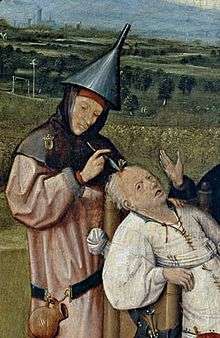Stone of madness
The stone of folly or the stone of madness refers to a hypothetical procedure in the 15th century involving trepanation and extraction of a stone, thought to be the cause of the patient's madness.[1][2] This procedure is demonstrated in the painting The Extraction of the Stone of Madness by Hieronymus Bosch.[3] The procedure and the painting depicting it inspired the 2002 Canadian short film The Stone of Folly.[4]
Gallery
 Quentin Massys: An Allegory of Folly (early 16th century). The fool has a "stone of folly" in his forehead.
Quentin Massys: An Allegory of Folly (early 16th century). The fool has a "stone of folly" in his forehead. Pieter Huys: A surgeon extracting the stone of folly
Pieter Huys: A surgeon extracting the stone of folly Pieter Jansz. Quast,
Pieter Jansz. Quast,
Die Steinoperation, ca 1630
References
- ↑ Vigué, Jordi (2002). Great Masters of Western Art. ISBN 0-8230-2113-0.
There was a popular belief that a so-called "stone of madness" caused idiocy or dementia. To cure this, it was believed necessary to remove a section of the ...
- ↑ Shorter, Edward. A History of Psychiatry. ISBN 0-471-24531-3.
In the Middle Ages, doctors fantasized about cutting for the mythical "stone of madness." In our own time, there is evidence that the course of Parkinson's ...
- ↑ Povoledo, Elisabetta (October 27, 2008). "In Rome, a New Museum Invites a Hands-On Approach to Insanity". The Economist. Retrieved 2008-10-28.
The logo of the Mind’s Museum is an overturned funnel. It is a reference to a 15th-century painting by Hieronymus Bosch that depicts a doctor using a scalpel to extract an object (the supposed “stone of madness”) from the skull of a patient. The doctor is wearing a funnel as a hat.
- ↑ Diskson, Alastair. "The Stone of Folly". Retrieved 2008-04-17.
External links
| Wikimedia Commons has media related to Trepanation. |
This article is issued from Wikipedia - version of the 10/20/2016. The text is available under the Creative Commons Attribution/Share Alike but additional terms may apply for the media files.
